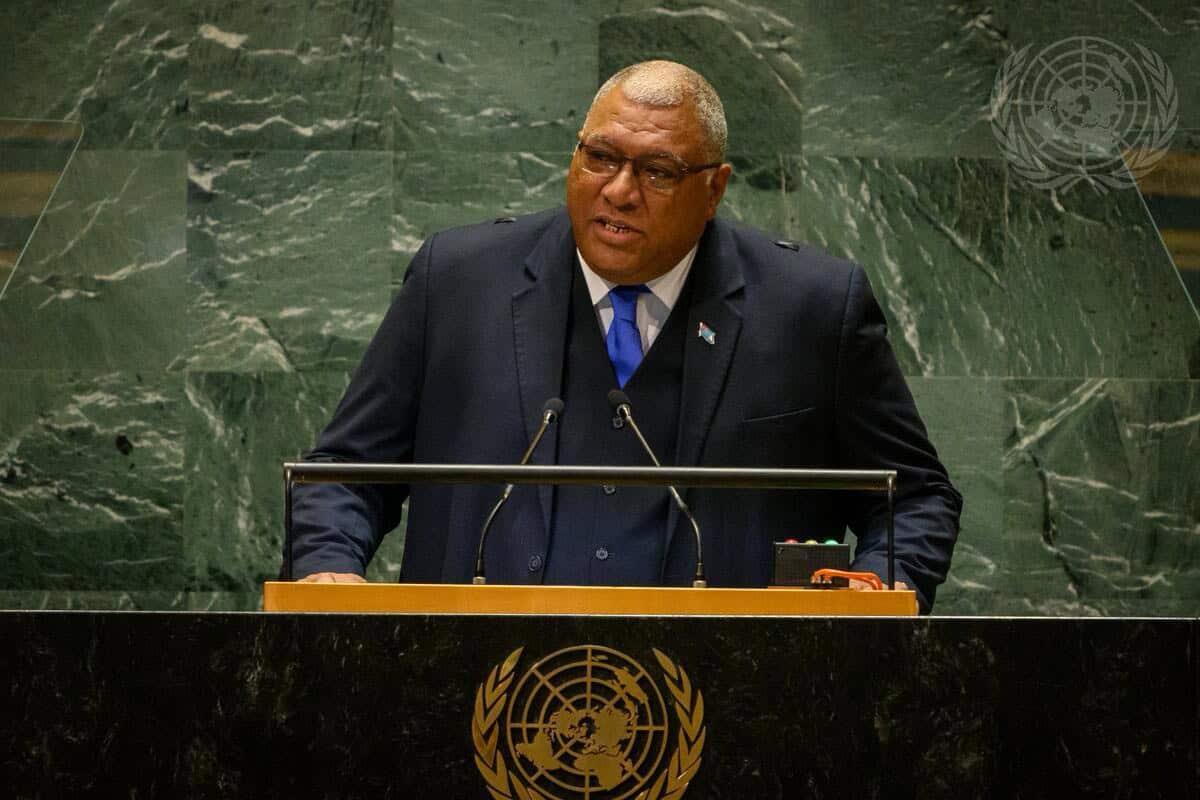Fiji’s President, Ratu Wiliame Katonivere, delivered a stinging rebuke to China’s recent ballistic missile test in the Pacific, calling for an end to provocative actions that threaten peace and security.
Speaking at the 79th United Nations General Assembly (UNGA) on 26 September in New York, President Katonivere condemned the test.
“There was a unilateral test firing of a ballistic missile into the Pacific Ocean.
“We urge respect for our region and call for cessation of such actions,” Katonivere declared, invoking the “Ocean of Peace” principles endorsed by Pacific leaders to uphold international law and peaceful coexistence.
“Our statements reinforce the Pacific’s peaceful example, and we urge others to refrain from actions that undermine peace and security in the Blue Pacific,” he stressed.
French Polynesia: ‘Not far’ from economic zone
French Polynesian President Moetai Brotherson earlier told AFP that “the missile fell not far from … the Marquesas Islands”, an archipelago that is part of its exclusive economic zone.
“The Chinese authorities previously notified their French counterparts of this test,” the French High Commission said in a statement – adding that France would make its position on the test known.
The Pentagon also said the United States received “some advanced notification of this ICBM test”, describing this as “a step in the right direction” that would help prevent “misperception or miscalculation”.
China’s military on Thursday released imagery of the missile, showing the projectile soaring into the air in a plum of smoke from an undisclosed location.
The Chinese Defence Ministry described the test launch as a “routine arrangement in our annual training plan” than is “in line with international law and international practice and is not directed against any country or target”
Analysts said the imagery suggested the launch could be of a Dongfeng-31 AG ICBM, unveiled during a military parade in 2017.
Beijing has stepped up its nuclear development and boosted defence spending in recent years, with the Pentagon warning last October that China was developing its arsenal more quickly than the United States had anticipated.
China held more than 500 operational nuclear warheads as of May 2023 and is likely to have more than 1,000 by 2030, the Pentagon said.
Guam to ‘boost defense’
Meanwhile, security threats posed by China have emerged as a key talking point for Guam’s congressional candidates following the launch of the ballistic missile on Wednesday.
Both the Republican and Democratic candidates agreed that China’s latest display of aggression represented a constant threat to Guam, underscoring the need to boost defense for the island.
James Moylan, the incumbent Guam delegate who is seeking reelection, said he advocated for the needed funding for the Guam missile defence system being proposed by the Department of Defence.
“This includes over US$500 million in the Fiscal Year 2024 National DefenCe AuthoriSation Act and over US$600 million in the Fiscal Year 2025 version, which is scheduled to be voted on in November,” said the Republican delegate.
His Democratic opponent, Ginger Cruz, however, said Guam needs to secure more federal resources for civil defence to protect the local population.
“Our island is woefully unprepared for potential armed conflict. While defense funding is essential, we need a comprehensive approach to protect both military and civilian populations,” Cruz said.
While the DOD’s combat preparations on Guam are mostly military-centric, discussions on contingency plans are quite scant, if at all, on the civilian side.
Cruz called for a “high-level coordination with the White House to enhance our civil defense, create civilian shelters, and harden our infrastructure.”
Guam pins its hope on the proposed integrated air and ground missile system with mobile components to be installed around the island.
For most residents, it was just another day in paradise. China’s missile threats don’t prompt Guamanians to change their daily routines.
“I don’t know that anyone can predict what China’s plan is enough to be truly prepared,” said Nadia Holm, an environmental scientist for a federal contractor.
“Not scared at all. We’ve been to this situation before with North Korea and I am confident that the U.S. military can thwart China’s threat,” said Gina Tabonares-Reilly of Barrigada,
The Offices of Guam Homeland Security and Civil Defence, U.S Naval Base Guam and Andersen Air Force Base announced a routine testing of the vital communication and advance warning system sirens on 01 October, starting at 3:15 pm.
GHS/OCD said it will test the all-hazards alert warning system sirens in conjunction with NBG and AAFB monthly routine testing of the giant voice sirens.
“Residents, visitors and motorists surrounding the AHAWS sirens and GV speakers can expect to hear pre-scripted voice messaging announcing the start and end of the test, and 60 seconds of the alert siren tone,” GHS/OCD said in an announcement.
“Future tests of the AHAWS sirens will be conducted on a monthly basis, in conjunction with NBG and AAFB, and will typically fall on the first Tuesday of each month, unless it falls on an observed holiday,” it added.
